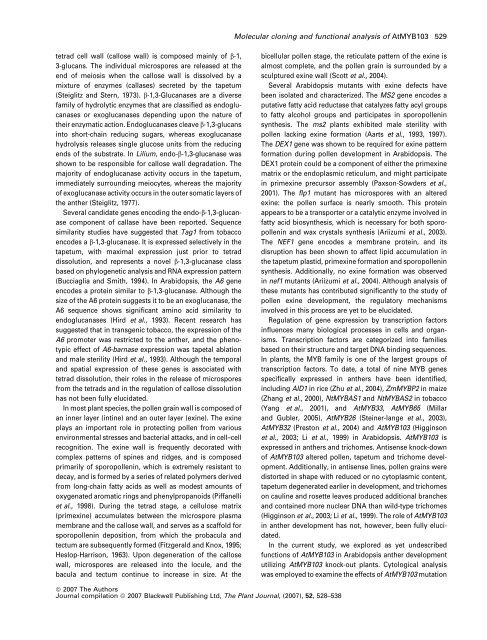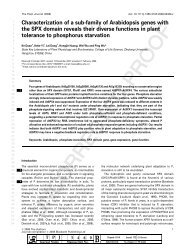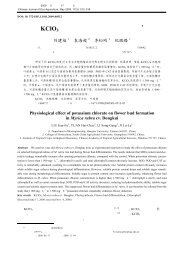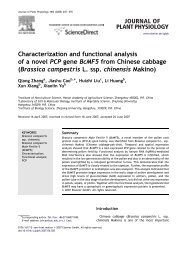You also want an ePaper? Increase the reach of your titles
YUMPU automatically turns print PDFs into web optimized ePapers that Google loves.
Molecular cloning and functional analysis of AtMYB103 529<br />
tetrad cell wall (callose wall) is composed mainly of b-1,<br />
3-glucans. The individual microspores are released at the<br />
end of meiosis when the callose wall is dissolved by a<br />
mixture of enzymes (callases) secreted by the tapetum<br />
(Steiglitz and Stern, 1973). b-1,3-Glucanases are a diverse<br />
family of hydrolytic enzymes that are classified as endoglucanases<br />
or exoglucanases depending upon the nature of<br />
their enzymatic action. Endoglucanases cleave b-1,3-glucans<br />
into short-chain reducing sugars, whereas exoglucanase<br />
hydrolysis releases single glucose units from the reducing<br />
ends of the substrate. In Lilium, endo-b-1,3-glucanase was<br />
shown to be responsible for callose wall degradation. The<br />
majority of endoglucanase activity occurs in the tapetum,<br />
immediately surrounding meiocytes, whereas the majority<br />
of exoglucanase activity occurs in the outer somatic layers of<br />
the anther (Steiglitz, 1977).<br />
Several candidate genes encoding the endo-b-1,3-glucanase<br />
component of callase have been reported. Sequence<br />
similarity studies have suggested that Tag1 from tobacco<br />
encodes a b-1,3-glucanase. It is expressed selectively in the<br />
tapetum, with maximal expression just prior to tetrad<br />
dissolution, and represents a novel b-1,3-glucanase class<br />
based on phylogenetic analysis and RNA expression pattern<br />
(Bucciaglia and Smith, 1994). In Arabidopsis, the A6 gene<br />
encodes a protein similar to b-1,3-glucanase. Although the<br />
size of the A6 protein suggests it to be an exoglucanase, the<br />
A6 sequence shows significant amino acid similarity to<br />
endoglucanases (Hird et al., 1993). Recent research has<br />
suggested that in transgenic tobacco, the expression of the<br />
A6 promoter was restricted to the anther, and the phenotypic<br />
effect of A6-barnase expression was tapetal ablation<br />
and male sterility (Hird et al., 1993). Although the temporal<br />
and spatial expression of these genes is associated with<br />
tetrad dissolution, their roles in the release of microspores<br />
from the tetrads and in the regulation of callose dissolution<br />
has not been fully elucidated.<br />
In most plant species, the pollen grain wall is composed of<br />
an inner layer (intine) and an outer layer (exine). The exine<br />
plays an important role in protecting pollen from various<br />
environmental stresses and bacterial attacks, and in cell–cell<br />
recognition. The exine wall is frequently decorated with<br />
complex patterns of spines and ridges, and is composed<br />
primarily of sporopollenin, which is extremely resistant to<br />
decay, and is formed by a series of related polymers derived<br />
from long-chain fatty acids as well as modest amounts of<br />
oxygenated aromatic rings and phenylpropanoids (Piffanelli<br />
et al., 1998). During the tetrad stage, a cellulose matrix<br />
(primexine) accumulates between the microspore plasma<br />
membrane and the callose wall, and serves as a scaffold for<br />
sporopollenin deposition, from which the probacula and<br />
tectum are subsequently formed (Fitzgerald and Knox, 1995;<br />
Heslop-Harrison, 1963). Upon degeneration of the callose<br />
wall, microspores are released into the locule, and the<br />
bacula and tectum continue to increase in size. At the<br />
bicellular pollen stage, the reticulate pattern of the exine is<br />
almost complete, and the pollen grain is surrounded by a<br />
sculptured exine wall (Scott et al., 2004).<br />
Several Arabidopsis mutants with exine defects have<br />
been isolated and characterized. The MS2 gene encodes a<br />
putative fatty acid reductase that catalyzes fatty acyl groups<br />
to fatty alcohol groups and participates in sporopollenin<br />
synthesis. The ms2 plants exhibited male sterility with<br />
pollen lacking exine formation (Aarts et al., 1993, 1997).<br />
The DEX1 gene was shown to be required for exine pattern<br />
formation during pollen development in Arabidopsis. The<br />
DEX1 protein could be a component of either the primexine<br />
matrix or the endoplasmic reticulum, and might participate<br />
in primexine precursor assembly (Paxson-Sowders et al.,<br />
2001). The flp1 mutant has microspores with an altered<br />
exine: the pollen surface is nearly smooth. This protein<br />
appears to be a transporter or a catalytic enzyme involved in<br />
fatty acid biosynthesis, which is necessary for both sporopollenin<br />
and wax crystals synthesis (Ariizumi et al., 2003).<br />
The NEF1 gene encodes a membrane protein, and its<br />
disruption has been shown to affect lipid accumulation in<br />
the tapetum plastid, primexine formation and sporopollenin<br />
synthesis. Additionally, no exine formation was observed<br />
in nef1 mutants (Ariizumi et al., 2004). Although analysis of<br />
these mutants has contributed significantly to the study of<br />
pollen exine development, the regulatory mechanisms<br />
involved in this process are yet to be elucidated.<br />
Regulation of gene expression by transcription factors<br />
influences many biological processes in cells and organisms.<br />
Transcription factors are categorized into families<br />
based on their structure and target DNA binding sequences.<br />
In plants, the MYB family is one of the largest groups of<br />
transcription factors. To date, a total of nine MYB genes<br />
specifically expressed in anthers have been identified,<br />
including AID1 in rice (Zhu et al., 2004), ZmMYBP2 in maize<br />
(Zhang et al., 2000), NtMYBAS1 and NtMYBAS2 in tobacco<br />
(Yang et al., 2001), and AtMYB33, AtMYB65 (Millar<br />
and Gubler, 2005), AtMYB26 (Steiner-lange et al., 2003),<br />
AtMYB32 (Preston et al., 2004) and AtMYB103 (Higginson<br />
et al., 2003; Li et al., 1999) in Arabidopsis. AtMYB103 is<br />
expressed in anthers and trichomes. Antisense knock-down<br />
of AtMYB103 altered pollen, tapetum and trichome development.<br />
Additionally, in antisense lines, pollen grains were<br />
distorted in shape with reduced or no cytoplasmic content,<br />
tapetum degenerated earlier in development, and trichomes<br />
on cauline and rosette leaves produced additional branches<br />
and contained more nuclear DNA than wild-type trichomes<br />
(Higginson et al., 2003; Li et al., 1999). The role of AtMYB103<br />
in anther development has not, however, been fully elucidated.<br />
In the current study, we explored as yet undescribed<br />
functions of AtMYB103 in Arabidopsis anther development<br />
utilizing AtMYB103 knock-out plants. Cytological analysis<br />
was employed to examine the effects of AtMYB103 mutation<br />
ª 2007 The Authors<br />
Journal compilation ª 2007 Blackwell Publishing Ltd, The Plant Journal, (2007), 52, 528–538








